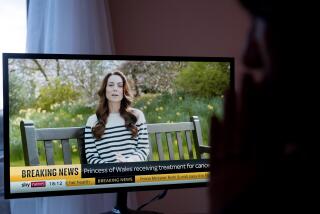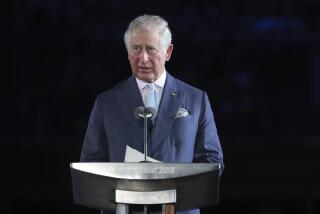Outrage Boils Up as a King’s Iron Grip Loosens : Nepal: Angry doctors tell of violence in the streets. Officials negotiate with the now-legal opposition.
KATMANDU, Nepal — Dr. Satyan Man Rajbhandari, his arm in a sling and the rest of his body badly bruised, stood before two senior government ministers and nearly 100 of his fellow doctors Tuesday night and described what happened the night that democracy came to this remote Himalayan kingdom.
After him came another doctor, and then another. And sitting there listening to all this, and to the cries of outrage that the accounts elicited, was King Birendra’s interior minister, Nain Bahadur Swanr.
It was an extraordinary display in a kingdom that has spent the last 30 years under repressive rule. Never had Nepalese confronted their rulers in such a way.
Tuesday’s dramatic scene at the Nepal Medical Assn. was a taste of the future for this impoverished nation of 18 million as it struggles to join the ranks of new democracies.
“This is a very dicey period,” said one diplomat here. “It’s precisely this mood of the doctors that adds to the uncertainty.
“We’re not talking about a bunch of wild-eyed radicals. These are highly educated professionals who were at the forefront of the pro-democracy movement. And if the king fails to move fast now with reforms, these people will be back in the streets and, the next time, the king may well not survive it.”
The doctors told one another Tuesday night of the horrors they had faced on the streets.
It was just one hour after Birendra’s historic announcement Sunday night declaring an end to the monarchy’s monopoly on power, Rajbhandari recounted, that he received an emergency call that his brother had been shot. The brother had been among the throngs defying a curfew order to celebrate in the streets and was cut down by soldiers who had not yet heard of Nepal’s new age of democracy.
“I rushed from the hospital, but when I reached the spot where my brother lay, the police pulled me out of the ambulance, forced me to lie face-down on the street and then kicked and beat me into unconsciousness,” the doctor said.
“Shame! Shame!” the roomful of doctors shouted angrily in unison.
Dr. Bharat Pradhan, head of Bir Hospital’s emergency room, told how he drove a second ambulance to rescue his fallen colleague, only to be turned back by soldiers who threatened to kill him if he tried to pass.
Finally, Dr. Lok Bikram Thapa, the hospital’s chief surgeon, told the huge gathering about his telephone call to Swanr, now seated just a few feet away.
“I appealed to the minister to order his police to allow our doctors through, but the minister told me: ‘You just shut up. You doctors are all troublemakers, and if you don’t stop your foolishness, I’ll send the police to shoot you all and burn down your hospital.’ ”
“Murderer! Murderer!” the doctors screamed at the minister seated before them. “Fire the bastard.”
Finally, Swanr stood up to defend himself, spending 15 minutes pleading for forgiveness. But it was clear that the elation of the Nepalese over their new-found democracy is not as powerful an emotion as their rage. When the minister had left the room, the doctors voted overwhelmingly to reject his apology. On Wednesday, they demanded that he resign.
In the days since the world watched hundreds of thousands of Nepalese dance, chant and sing in the streets, the king’s four handpicked Cabinet ministers have been locked in intensive negotiations with the leaders of the country’s now-legal political parties. Their goal is to create a tripartite interim government that will amend the constitution and schedule national elections.
But infighting has begun among the opposition parties that led the eight-week protest movement, a disparate coalition of seven Communist parties and the centrist Nepali Congress Party.
The Communist leaders are demanding that the king dissolve the rubber-stamp National Assembly before they will join an interim Cabinet, while some Congress Party leaders privately have indicated that they will join without any conditions.
Negotiations are further hampered by a deep mistrust of the palace among political leaders who were jailed for years after Birendra’s father outlawed party politics in a 1960 palace coup.
There is also sharp disagreement among the three factions about how to punish the corrupt and abusive members of the hard-line Cabinet that Birendra fired a week ago in a desperate bid to defuse the crisis. Loud chants calling for former Prime Minister Marich Man Singh Shrestha to be hanged filled Katmandu’s streets during Monday’s massive democracy celebration, indicating the depth of sentiment for revenge. He had ordered police to open fire on demonstrators during weeks of protest.
But senior government officials and independent analysts say that any extensive investigation into public corruption and abuse of power would lead directly to the king’s palace, which is believed by most Nepalese to have been the real power behind the appointed council of ministers.
In interviews with several senior Nepalese officials, it was clear that the palace knows it has moved only halfway toward full democracy.
“We are all aware, including the king himself, that this is going to be a very turbulent transition,” the newly appointed foreign minister, Pashupati Shamsher Rana, said in an interview Tuesday. “We are also aware that we have to re-establish a lot of trust, and we have to restore the credibility of the crown. But, clearly, the king has taken a very major decision. It is a major shift in direction, so there is really no going back on that now.”
It is equally clear, though, that the image of the king, a symbol of Nepalese nationalism needed to protect the country’s sovereignty from Indian influence, has suffered badly during the eight weeks of pro-democracy protests.
The king, and to a greater extent, his wife, Queen Ratna, have been derided as thieves or worse in slogans chanted in the streets. Nepalese from all walks of life now believe that the queen and her family secretly have been running the country from behind the king’s robes for the past two years. Posters throughout the city picture the king’s mouth closed with a zipper held shut by a small queen.
“The people themselves are trying to isolate the blame on the queen, in part because everyone knows the monarchy is a necessary foil against interference from our big southern neighbor,” said a senior government official who asked not to be identified by name.
There are other reasons to help explain the level of popular outrage.
“More than 90% of the population in Katmandu believes that the queen and her family have stolen millions from the country,” said a primary school teacher who identified himself only as “a true democrat” at Monday’s celebration rally. “But we also blame the king for creating an entire cult of corruption throughout our society.”
However, the anger of the doctors, nurses and other medical professionals in the capital is rooted in more than palace scandals and rumors of corruption.
After weeks of removing bullets, stitching up the gashes caused by riot sticks and watching patients die as a result of the government’s policy since February of meeting protest with force, the hospital staffs organized their own protests, which many analysts cited as the turning point for the pro-democracy movement.
Their anger reached fever pitch Friday when police gunned down scores of unarmed demonstrators as they began marching toward the palace gates. Several government sources said that huge demonstration convinced the king that he was politically cornered.
But the bloodshed also convinced the doctors at Bir Hospital that much more is needed than the king’s brief announcement Sunday legalizing political parties.
“We have only come halfway--in fact, not even halfway,” said a doctor in the hospital staff room Tuesday. “Something has begun, and the people are waiting to see where it will go, but no one is satisfied.”
Another doctor added, “The world will forget what has come before here in Nepal. It is always that way. But we will not allow the Nepalese to forget.”
More to Read
Sign up for Essential California
The most important California stories and recommendations in your inbox every morning.
You may occasionally receive promotional content from the Los Angeles Times.










